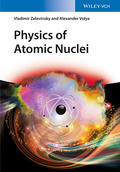Physics of Atomic Nuclei

1. Auflage April 2017
XVI, 667 Seiten, Hardcover
150 Abbildungen (121 Farbabbildungen)
Lehrbuch
Kurzbeschreibung
Das vorliegende Lehrbuch für Fortgeschrittene führt Studenten von den grundlegenden Ideen zu aktuelleren Themen und entscheidenden Entwicklungen der letzten 20 Jahre. Im Ergebnis liegt damit eine neuartige und umfassende Darstellung der wichtigsten aktuellen Atomkernmodelle vor.
Jetzt kaufen
Preis: 132,00 €
Preis inkl. MwSt, zzgl. Versand
Euro-Preise für Wiley-VCH- und Ernst & Sohn-Titel sind nur für Deutschland gültig. In EU-Ländern gilt die lokale Mehrwertsteuer. Portokosten werden berechnet.
This advanced textbook presents an extensive and diverse study of low-energy nuclear physics considering the nucleus as a quantum system of strongly interacting constituents.
The contents guide students from the basic facts and ideas to more modern topics including important developments over the last 20 years, resulting in a discussion of major modern-day nuclear models otherwise unavailable in the textbooks. The book emphasizes the common features of the nucleus and other many-body mesoscopic systems currently in the center of interest in physics. The authors have also included problem sets that can be selected by lecturers and adjusted to specific interests for more advanced students, with many chapters containing links to freely available computer codes. As a result, readers are equipped for scientific work in mesoscopic physics.
Isospin
Two-Body Dynamics and the Deuteron
Two-Body Scattering
Liquid Drop Model
Vibrations of a Spherical Nucleus
Fermi-Gas Model
Semiclassical Description
Spherical Mean Field
Independent Particle Shell Model
Light Nuclei
Many-Body Operator Formalism
Nuclear Deformation
Deformed Mean Field
Pairing Correlations
Gamma-Radiation
Nuclear Gamma-Transitions
Related Electromagnetic Processes
Quantum Rotation
Nucleus as a Rotor
Cranking Model
Self-Consistent Field
Shell Model
Collective Modes
Statistical Properties
Weak Interactions
Nuclear Fission
Bosons, Symmetries and Group Models
Heavy Ion Reactions
Nucleus as Chaotic System
Alexander Volya is professor of Physics at the Florida State University, USA. His education includes diploma from Tallinn Tynismae Science School, Estonia; bachelor's degree from St. Petersburg State University, Russia; doctoral degree in theoretical nuclear physics from Michigan State University; and postgraduate research work at the Argonne National Laboratory. In the fall of 2003, he joined the faculty at Florida State University where he currently leads a research program in theoretical nuclear physics and mesoscopic physics. He has published over 100 publications and has been regularly teaching nuclear physics courses at Florida State University.


